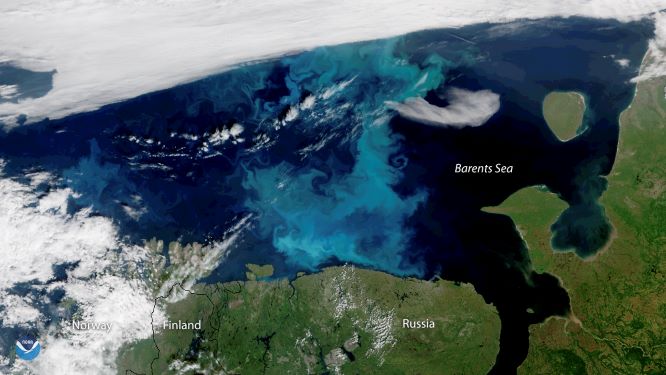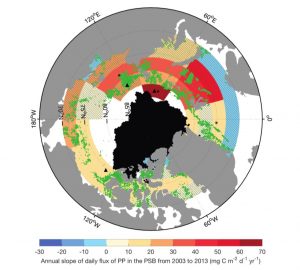This
needs more investigation. We have been picking up considerable areas
of green in the Arctic sea and wondering if it could be algal blooms.
Maybe it is phytoplankton?
ARCTIC
SEA ICE DECLINE DRIVING OCEAN PHYTOPLANKTON FARTHER NORTH
15
October, 2018
WASHINGTON
— Phytoplankton blooms that form the base of the marine food web
are expanding northward into ice-free waters where they have never
been seen before, according to new research.
A
new study based on satellite imagery of ocean color reveals
phytoplankton spring blooms in the Arctic Ocean, which were
previously nonexistent, are expanding northward at a rate of 1 degree
of latitude per decade. Although blooms, or large explosions of
phytoplankton, did not previously occur in this area, phytoplankton
were present in the Arctic’s central basin at low biomass. The
study also found the primary productivity of the phytoplankton, or
the rate at which phytoplankton are converting sunlight into chemical
energy, is increasing during the spring blooms.
This
true-color image, captured by the NOAA-20 satellite on July 30,
2018, shows a large phytoplankton bloom in the Barents Sea. Credit:
NOAA Environmental Visualization Laboratory
The
decline in Arctic sea ice over the past several decades has made way
for areas of open water where phytoplankton can thrive, driving their
northward expansion, according to the study’s authors. The
researchers are unsure what effect this expansion will have on the
food web, but the results suggest the decline of ice cover is
impacting marine ecosystems in unforeseen ways.
If
sea ice continues to decline, it could drive phytoplankton spring
blooms farther north and increase primary productivity even more.
These changes could affect the fate of the Arctic Ocean as a carbon
source or a carbon sink, according to the study.
“If
the ice pack totally disappears in summer, there will be consequences
for the phytoplankton spring bloom,” said Sophie Renaut, a Ph.D.
student at Laval University in Quebec City, Canada, and lead author
of the new
study in Geophysical
Research Letters,
a journal of the American Geophysical Union. “We cannot exactly
predict how it will evolve, but we’re pretty sure there are going
to be drastic consequences for the entire ecosystem.”
Phytoplankton
in the ecosystem
Phytoplankton
are microscopic organisms that live in water, consume carbon dioxide
and release oxygen through photosynthesis. In this process, they
convert sunlight into chemical energy. Phytoplankton form the base of
the marine food web, indirectly feeding everything from small fish to
multi-ton whales.
Phytoplankton
growth depends on the availability of carbon dioxide, sunlight,
nutrients, water temperature and salinity, water depth and grazing
animals, according to the NASA
Earth Observatory.
When conditions are ideal, phytoplankton population growth can
explode, or bloom. While a bloom may last several weeks, the lifespan
of an individual phytoplankton is seldom more than a few days.
Phytoplankton
in the Arctic Ocean typically bloom every spring. In the past,
phytoplankton blooms have been virtually absent from the highest
Arctic latitudes, because these areas are usually covered by sea ice.
In recent decades sea ice has declined, breaking up earlier in the
spring or not forming at all in some areas of the Arctic.
In
the new study, Renaut and her colleagues wanted to see if recent sea
ice declines have had any effect on spring phytoplankton blooms. They
used satellite observations of ocean color—which provide estimates
of phytoplankton biomass and primary productivity—to track changes
of the blooms each spring from 2003 to 2013.
They
found the spring blooms are expanding farther north and increasing in
primary productivity. In the spring and summer months, net primary
productivity in the Arctic Ocean increased by 31 percent between 2003
and 2013, according to the study. The researchers also found that
these blooms in the Barents and Kara Seas, north of Russia, are
expanding north at a rate of 1 degree of latitude per decade.
Estimates
of annual trends in daily flux of primary productivity (PP) during
the phytoplankton spring bloom determined from satellite ocean color
data. Green pixels correspond to new phytoplankton spring blooms
observed since 2010. Credit:
S. Renaut et al. 2018
Unexpected effects of sea ice decline
Sea
ice melt occurring earlier in the season creates larger open water
areas that act as incubators for phytoplankton growth and elongate
their growing season, according to Renaut.
The
authors suspect spring blooms could someday extend into the Arctic’s
central basin, which encompasses almost everything north of 80
degrees latitude.
Primary productivity, though, would likely remain
low due to a lack of nutrients. Less ice cover means spring blooms
and under-ice blooms may also have to compete for light and
nutrients, thus altering the flow of the marine ecosystem. The
results suggest a large change in this region, which has never been
free of ice cover.
“The
polar regions—the Southern Ocean and the Arctic Ocean—they’re
really important because they play a critical role in regulating the
global climate,” Renaut said. “If sea ice disappears completely
in summer in the Arctic Ocean, which is what we expect in some
decades, it’s going to have an impact on the ecosystem but also
likely on the climate.”
Patricia
Yager, professor of Marine Sciences at the University of Georgia who
was not involved with the new study, said the earlier algal bloom
growth they observed in some areas could have considerable impacts if
animals are not yet ready to graze on the phytoplankton.
“Such
a mismatch in time could cause major changes to the Arctic food web,
impacting not only the local animals and the people who live there,
but also the global population of migrating animals who depend on
these Arctic resources,” Yager said. “What happens in the Arctic
does not stay in the Arctic.”
Cecile
Rousseaux, a research scientist at the Universities Space Research
Association, who was not involved in the new study, said the study
advances research in this area by investigating individual regions of
the Arctic for phytoplankton productivity, and represents evidence of
the effects that reduced ice cover have on the biochemical cycle of
the Arctic Ocean. However, Rousseaux noted that the study does have
limitations.
“It
is also important to remember that we are currently limited by the
amount of data available to study these changes,” Rousseaux said.
“Longer time series of satellite data will allow us to confirm
whether these trends in phytoplankton productivity persist or not.”
Authors:
Sophie Renaut, Marcel Babin: Takuvik Joint International Laboratory, CNRS, Laval University, Québec, Québec, Canada;
Emmanuel
Devred: Takuvik
Joint International Laboratory, CNRS, Laval University, Québec,
Québec, Canada and Ecosystem and Ocean Sciences Division, Bedford
Institute of Oceanography, Department of Fisheries and Oceans,
Dartmouth, Nova Scotia, Canada
Contact
information for the authors:
Sophie Renaut: sophie.renaut@takuvik.ulaval.ca, +1 (418) 523-9821
Sophie Renaut: sophie.renaut@takuvik.ulaval.ca, +1 (418) 523-9821





No comments:
Post a Comment
Note: only a member of this blog may post a comment.